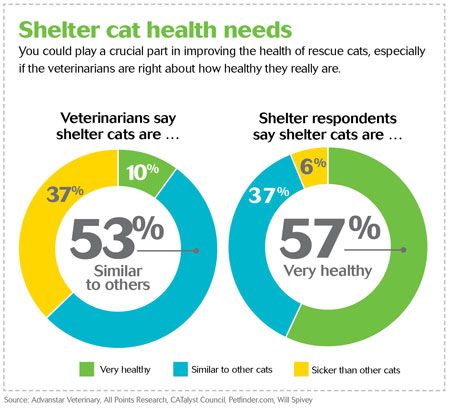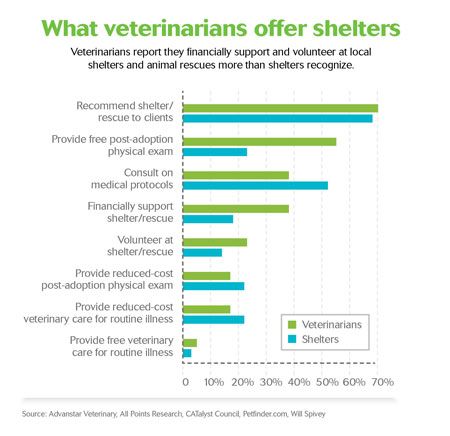Shelters and veterinarians: The problem with cats
Too many felines are surrendered to animal shelters or abandoned. A new survey checks in on animal shelters, rescue groups, and veterinarians to find new ways they can work together.
Next >
The reason for a new survey from the feline advocacy group CATalyst Council is simple. “Cats enter shelters at a greater rate than they can find a home,” says Dr. Jane Brunt, the feline organization’s executive director. That’s a problem that veterinarians, animal control facilities, animal shelters, and rescue groups would love to help solve. Yet today, in many communities, veterinarians and shelters are indifferent to one another and sometimes downright unhappy.
Some veterinarians complain that animal shelters offer an increasing array of veterinary medical services at a lower cost, thanks to subsidies, donations, and nonprofit tax benefits. On the other side, some shelter employees and volunteers see that the need for veterinary care for all animals in their communities isn’t being met by local practitioners.
What did these shelter respondents say they want from veterinarians? See “What we want” on page 20, but you’ve already guessed: What shelters need from local veterinarians are low-cost or free services.
There’s a perception among some that neither group is helping enough:
- 41 percent of veterinarians say they support shelters, but shelters don’t support them.
- 35 percent of shelter respondents say they support veterinarians, but veterinarians don’t support them.
- 54 percent of veterinarians say shelters are competing with veterinarians. Only 4 percent of shelter respondents agree.
It’s high time to change those perceptions, says Veterinary Economics Editorial Advisory board member Dr. Ernie Ward.
All paws in
The often unspoken fear of veterinarians who might be willing to visit the local shelter, advise and educate the shelter team, and offer some pro bono or discounted work is, of course, that the fire hose of need will drown them.
“We’re afraid that if we open our big mouths to offer to help, a big foot will be inserted with 100 stray dog and cat spays a day,” says Dr. Ward, owner of Seaside Animal Care in Calabash, N.C. “We’re worried that people will take advantage of us.”
That’s why you need a plan, he says. “You need to know what you can offer and when you can offer it,” he says.
Dr. Ward makes a few calls every year to local rescue groups and asks them the question, “What do you need from me?” The groups are uniformly grateful for his initiative.
“Too often, when we wait for shelters to reach out to us, it becomes a transactional relationship,” Dr. Ward says. “They’re just worried, ‘How much is this going to cost?’” Be proactive and explain what you can do, not what you can’t.
Of course, local emergencies do arise. Dr. Ward recommends you become the hero: Come up with creative—usually obvious—solutions that can help the work get done but ease the strain on your practice. For instance, instead of turning down a local woman with 36 cats to be treated, examined, and rehomed, Dr. Ward suggested to the cat rescuer that she also reach out to other veterinarians to spread the spaying, neutering, and medical work. It worked out for all involved.

Purr-fect results
Before reaching out to help, make sure you’ve got a plan so you know how much you’ll charge animal organizations for services and how much, if anything, you can give away for free. Dr. Ward sits down after the holidays in January each year and figures out what he can reasonably charge for spays, neuters, and other services for animal shelters and rescue groups. He offers every group the same discounted price, so word doesn’t get out that he’s offering a lower cost to one group instead of another.
Dr. Ward has also been instrumental in organizing an umbrella group of local rescues in his community. This one organization helps distribute products and services from participating veterinarians fairly to all the groups in the area—not just those who ask first.

Feline future
Differences aside, the CATalyst Council’s Dr. Brunt is hopeful that shelters and veterinarians share enough common ground to work together in their communities to improve the health and adoption rates of felines. Two-thirds of shelters and veterinarians said they were interested in a program to work together to get owners of newly adopted cats connected with a veterinarian. Two-thirds are concerned about shelter-veterinarian relationships in their community.
Ultimately, we all share the same goal, says Veterinary Economics Editorial Advisory Board member Dr. Andy Rollo, an associate at Madison Veterinary Hospital in Madison Heights, Mich: “We all want to provide better care and better conditions for these pets that can’t speak for themselves.”
